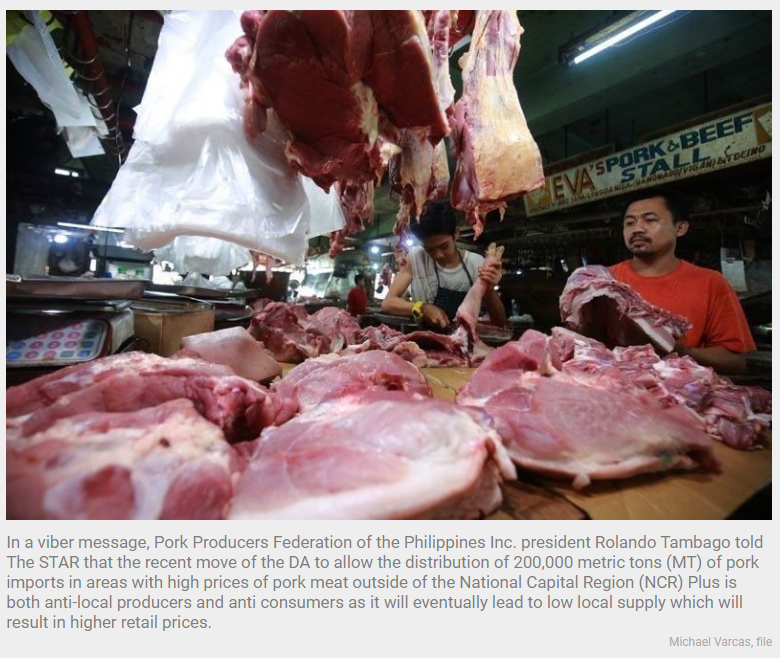Philippines: Pork producers slam MAV Plus expansion
MANILA, Philippines — Local pork producers have slammed the move of the Department of Agriculture (DA) to expand the distribution areas of pork imports under the minimum access volume (MAV) Plus, saying it will further hurt the local sector and not reduce the prices of pork.
In a viber message, Pork Producers Federation of the Philippines Inc. president Rolando Tambago told The STAR that the recent move of the DA to allow the distribution of 200,000 metric tons (MT) of pork imports in areas with high prices of pork meat outside of the National Capital Region (NCR) Plus is both anti-local producers and anti consumers as it will eventually lead to low local supply which will result in higher retail prices.
“Reliance on imported commodities like pork is not a sustainable approach,” Tambago said.
On Monday, Agriculture Secretary William Dar issued Memorandum Circular 23, which allows the distribution of pork imports under the MAV Plus outside of the original target areas of Metro Manila, Bulacan, Rizal, Laguna and Cavite, in a bid to address the high meat inflation in majority of the country’s regions.
Latest data from Philippine Statistics Authority (PSA) showed that meat inflation slightly decreased to 15.6 percent in September from 16.4 percent in the previous month.
Meat inflation in NCR declined to 14.4 percent from 16.2 percent,while meat inflation declined in areas outside of NCR but at a slower rate of 15.9 percent.
PSA data showed that all regions, except the Bangsamoro Autonomous Region in Muslim Mindanao (BARMM), posted double digit meat inflation rates in September.
Tambago emphasized that the main purpose of increasing the MAV to 254,000 MT through Executive Order (EO) 133 and the decrease of tariff through EO 134 is to reduce retail price at all markets in NCR where there is a shortage of pork due to the impact of African swine fever (ASF) in Luzon.
“Why is he (Dar) expanding the distribution of in-quota allocation to other regions where there is no shortage of pork,”Tambago said.
“In fact, in Visayas and Mindanao we are even experiencing a massive surplus of pork,” saying that VisMin local pork producers are even sending a lot of supply right now to Luzon.
Tambago also pointed out that the DA did not identify the specific areas where the imported pork under the MAV Plus would be distributed to.
Meanwhile, the memorandum circular also expands the distribution channels as it allows the selling of pork under the MAV Plus to processors and institutional buyers.
In a statement, the Philippine Association of Meat Processors Inc. (PAMPI) said the measure to expand the coverage area of the MAV Plus would not address the unabated high prices of pork, mainly due to policies banning the sale of frozen pork in wet markets without freezers.
“The high prices of meat products which the government has miserably failed to address is due to dysfunctional policies of the DA which misled economic managers in the executive department,” PAMPI said.
“The DA had recommended the expansion of MAV and reduction of pork tariffs without notifying other gov’t agencies that the imported pork cannot be sold in wet markets unless they are displayed in freezers and kept at a temperature of minus 18 degrees Celsius,”the group said.
PAMPI stressed that stall owners in wet markets are unable to sell imported pork as they do not have freezers.
“On the other hand, importers/traders who fell for the reduced tariff incentive cannot move their imported pork to the wet markets, incurring unnecessary storage cost because the National Meat Inspection Service (NMIS) of the DA has threatened to confiscate them,”the group said.
This has resulted in imported pork products being tied up in cold storages.
Latest data from the National Meat Inspection Service (NMIS) showed that the inventory of frozen pork in accredited cold storages as of Oct. 11 stood 73,294 MT, 65.8 percent higher than the 45,766 MT frozen pork inventory in the same period last year.
NMIS data showed that imported pork accounted for the bulk of the inventory at 71,528 MT, while local pork comprised only 1,766.3 MT.
The Calabarzon region registered the largest volume of imported pork during the period at 22,729.9 MT. It also had the largest share of local frozen pork at 880.57 MT.
The National Capital Region (NCR) also accounted for the bulk of the imported frozen pork at 22,222 MT.
Central Luzon and Central Visayas also had a sizable share of the imported frozen pork at 15,018 MT and 10,755 MT, respectively.
To bring pork prices down, PAMPI said the DA should temporarily suspend the implementation of a policy which bans the sale of frozen meat products in wet markets.
Source: https://www.philstar.com/business/2021/10/28/2137107/pork-producers-slam-mav-plus-expansion


 English
English




